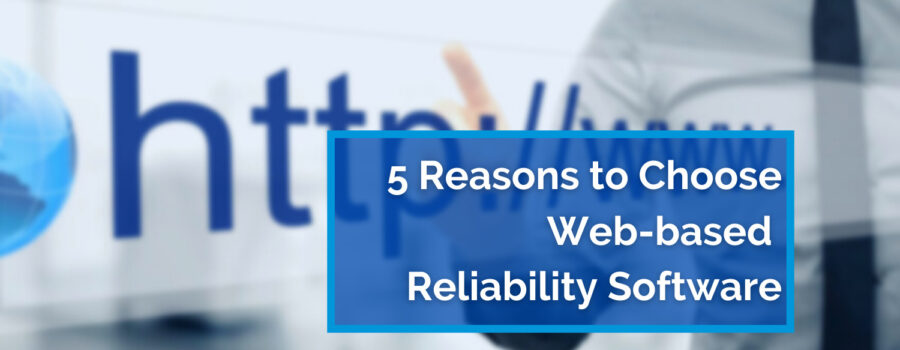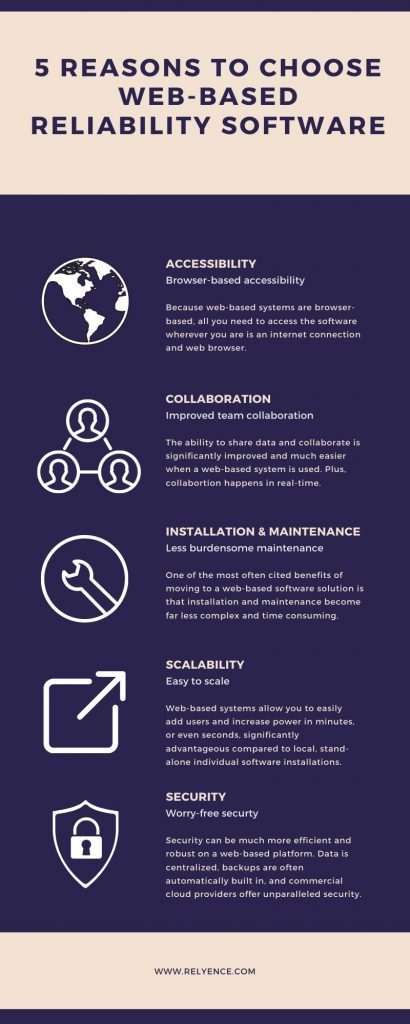What is Web-based Reliability Software?
Web-based software applications or solutions are accessed and used within a web browser such as Google Chrome, Apple Safari, Microsoft Edge, and Mozilla Firefox. Other terms that are sometimes used to describe web-based software are browser-based or web platform. Web-based applications are installed on a host server, rather than on individual computers. Therefore, sometimes the term server-based is used to refer to a software solution which is not installed on every person’s individual computer, such as a web-based solution. Web-based reliability software refers to software packages used to perform reliability analysis that operate on a web-based platform.
We interact with web-based software every day. For example, online shopping markets and banking apps are all web-based applications. You bring up your preferred browser, log in to your account, and then proceed to perform whatever tasks you need to do. You do not have to download and install anything onto your own computer to do this. All the features and functions you need are at your fingertips in your web browser.
Web-based vs Individual Installation
Some of us remember days when software applications we wanted to use were purchased and installed on our own computers. Originally, these were boxed applications that were purchased from a store. We’d bring home our purchase and open it to find a CD which held the software to install. A little further down the road, we skipped the box and advanced to simply downloading the applications from the internet. However, we still installed them on individual computers once downloaded.
Some installed applications are still in use today and may be preferred in special situations. However, most of us now want the ease and benefits of web-based applications for our personal as well as our work-related tasks. In some cases, highly sophisticated software used for business reasons are legacy applications (meaning developed long ago) that are not available in a web-based form. Because of their long history of use, it can be tempting to continue using these legacy products. However, there are many benefits to moving toward web-based solutions and away from installed applications. Additionally, there are now very few areas where a web-based software solution is not available.
What are the Benefits of Web-based Reliability Software?
There is a long list of advantages to using web-based software over installable solutions for your reliability software needs. It can be difficult to pare down the list! This article will look into some of the topmost reasons to move to a web-based reliability analysis platform. These benefits are not in any priority order; however, certain advantages may be more important to your specific situation. The five we will examine are:
- Accessibility
- Collaboration
- Installation and Maintenance
- Scalability
- Security
#1 Accessibility
An often-noted advantage of web-based applications is their undeniable accessibility. This accessibility encompasses several factors: availability, reach, and device independence.
Because web-based reliability software is browser-based, all you need to access the software wherever you are is an internet connection and web browser. You still need to provide your log in credentials in order to access the system, but it can be done from any location, at any time. In Relyence terms, we refer to this as our “anytime, anywhere” access. Relyence is available around the world 24/7, so you can work when and where you choose. The availability of a web-based system supports flexible work schedules, work from home, and the time zone variations of global teams.
Due to the browser-based interface, you and your coworkers in other states, or even countries, have complete access to the same software. The reach of a web-based system easily scales to include any team member with a web browser. That way, your team can perform the necessary tasks unimpeded and without the need for IT involvement. Additionally, software can be accessed whether you are at work, at home, or traveling simply by opening your web browser. The reach of a web-based system is limited only by the reach of an internet connection.

Another bonus of web-based reliability software applications is the ability to access them on various devices. Any device that includes the ability to launch a browser can use the software. This means that along with working on your desktop or laptop, you can also use your tablet or smartphone if you want. This flexibility allows easy access to the software for those team members working on a job site, in a manufacturing plant, or anywhere else in the field. Web-based applications are mobile friendly and easily adaptable to today’s device independent needs.
#2 Collaboration
If you have experience using locally installed software applications, you can understand the frustration that occurs when trying to collaborate with your team. There are many issues that arise when everyone is using their own installed version of a software application and project work needs to be shared:
- Team members may be storing data locally on their own computer, so in order to share with teammates, you may have to email or download a data file.
- Team members may not be using the same version of the software. Perhaps someone didn’t install the latest version. In many cases this means that data files are not compatible due to the required file conversions between software revisions.
- Data files may be centrally located, but it is difficult to track who modified the files or if team members are simultaneously updating the same data.
The ability to share data and collaborate is significantly improved and much easier when web-based reliability software is used. First, data is stored in a central location and can be shared by all essential team members. Therefore, you are assured that everyone is using the same version of data files. Also, you are certain that everyone is accessing the most recent data and that no one is accidentally using an outdated version.
Web-based systems also enable you to collaborate in real-time. Instead of generating reports or presentations, all team members can log in and view active project data. For example, in Relyence, useful dashboard overviews enable you to share important information that is gathered real-time.
Collaborative activities also extend beyond your team. In situations where cross-team interactions and data sharing may be vital, web-based solution offer unique benefits. Web-based systems offer interoperability capabilities unlike locally installed applications. For example, it is much easier to integrate your web-based reliability software with other web-based analytical tools. In some cases, you may even be able to share the same backend database, enabling even more effective data management. With stand-alone installs it is very difficult to integrate two platforms together, especially when higher end applications tend to be proprietary.
The ability to integrate software applications allows you to manage your workflow and processes for maximum efficiency. When you are working with separate software systems, it becomes a cumbersome task to accumulate data from all the necessary sources in order to get a holistic picture of your business performance.
#3: Installation and Maintenance
One of the most often cited benefits of moving to a web-based software solution is that installation and maintenance become far less complex and time consuming. When a new version or upgrade is available in a web-based application, it is immediately installed on a single computer or the host server. It is then instantly available to all team members with no need to update everyone’s computer.
In a web-based environment, the host server may be a computer at your organization’s location. Or it may be hosted by the software vendor or a well-established third-party vendor such as Microsoft Cloud or Amazon AWS. When hosted outside your organization, the level of effort is even further reduced. In this case, new versions and upgrades are offloaded to the third-party vendor to handle. This can significantly decrease the workload required of you or your IT team.
 Another consideration: with web-based reliability software, you only need a web browser in order to access the analysis tool. Because each and every computer is not required to install and load the software, it can be run on lower powered computers. Not everyone needs a machine that can handle the memory and power requirements of the host server.
Another consideration: with web-based reliability software, you only need a web browser in order to access the analysis tool. Because each and every computer is not required to install and load the software, it can be run on lower powered computers. Not everyone needs a machine that can handle the memory and power requirements of the host server.
Also, because everyone is accessing the software on the host computer, everyone is guaranteed to be using the same version of the software. There is no longer the mismatch of some people using older versions, and in turn, older data files. Consistency of software and file versions is greatly improved, allowing for increased efficiency.
#4 Scalability
One big disadvantage of client installed applications is the difficulty in scaling up. For example, consider something as simple as adding a new team member. When you are using locally installed software and someone new comes on board you must purchase a new computer that is capable of running the software and install it on that new machine. When employing a web-based alternative, there is nothing to install, and you likely will not need as high-powered of a computer for your new team member. All you need to do is provide new log in credentials to your new employee to get them up and running on day one.
Web-based reliability software is built to enable you to add users easily, often with a permissions-based mechanism to control what tasks users are allowed to perform. For example, in Relyence, there is a simple and comprehensive Manage Users and Groups feature. In this way, you can add or remove users and set up user profiles as needed. A few example permissions-based profiles that can be set up include:
- An Administrators group whose users can perform all operations
- A FMEA group whose users can edit FMEA Worksheets
- A FMEA group whose users can only view FMEA Worksheets
- A Design group whose users can access Fault Tree, Reliability Prediction, and RBD
- A Management group whose users can only view Dashboard data summaries
Essentially, the ability to manage your team as you grow and expand responsibilities is easy using a web-based platform.
Another advantage of a web-based system is the ability to easily upgrade the power of the hosting platform. Recognized cloud providers offer efficient mechanisms to increase server power, cluster servers, add servers in other locations, and more in order to make scaling up much easier.
Web-based systems allow you to easily add users and increase power in minutes, or even seconds. It’s a huge advantage compared to buying hardware, installing software, and configuring each and every team member’s computer.
#5 Security
Cloud-based or web-based systems are sometimes thought of as less secure than the traditional desktop-based software solutions. This is not the case, and in many significant ways, web-based reliability software solutions offer a much more secure environment.
With desktop software, your computer can be lost, stolen, or damaged. Many people have experienced the heart-dropping moment of a computer failure and thinking, “When was the last time I backed up?!” In this instance, a web-based solution provides two huge benefits.
First, there is no need to reinstall the software. In the case when you are using desktop software that is licensed in some way, reinstallation can be difficult and problematic. With web-based software, you simply need to move to another computer or device with a web browser to regain access to your application.
Second, with data stored on an outside server or in the cloud, you have not lost any data due to your computer failing. Using a web-based application, you have peace of mind knowing your ability to get back up and running after a disaster is quick and painless.
 When considering backups, web-based systems typically perform backups automatically for you. In the event of data loss, you can usually restore easily. This is especially true when using well-established cloud providers, such as Microsoft and Amazon, which have built-in backup and restore features.
When considering backups, web-based systems typically perform backups automatically for you. In the event of data loss, you can usually restore easily. This is especially true when using well-established cloud providers, such as Microsoft and Amazon, which have built-in backup and restore features.
Web-based applications run on host servers, which are monitored and maintained either by a third party or experienced internal IT professionals. This allows security to be tightly regulated by the efficient monitoring and control of a single host computer. Compare this to trying to manage and maintain security across everyone’s individual computer for a locally installed application. Security can be much more efficient and robust on a web-based platform.
Finally, if a web-based application is hosted on a widely used and supported cloud platform, such a Microsoft Cloud or Amazon AWS, you can be sure that security is of paramount concern. These large-scale cloud providers expend large resources on ensuring their system’s security. It is easier in many cases to rely on the expertise of these professionals for your data security.
Cost Advantages of Web-based Reliability Software
Due to the fact that pricing structure for purchase typically differs between web-based reliability software and locally installed software, cost comparisons can be difficult to assess. Instead of the one-time license fee often used with locally installed software, web-based models usually employ a subscription-based fee system. With a subscription-based model, you are paying a lower entrance fee and your costs are distributed over time.
A benefit of the subscription pricing model is that since costs are based per user, it is easier to add more users as needed. With a locally installed software package, you must buy additional licenses for each new user. This not only becomes expensive, but also is more burdensome for you or your IT staff. You must download and install a new copy for each new user. With a subscription model, you simply activate a new user and incur a small increase in your monthly subscription fee.
However, beyond the pricing structure differences, the advantages of web-based reliability software solutions in terms of cost are a common factor running through all the benefits outlined above.
As mentioned before, a web-based model can significantly decrease your hardware costs. For high-powered analytical software such as Relyence, high-end computers are needed in order to capably run the software and perform the complex calculations. Performance is not optimal when lower end hardware is used. With a web-based set up, only the main host server must be high powered. Because each individual team member is not independently running the software and needs only a browser, they can use less powerful (i.e., less costly) machines compared to the host server.
Also, your IT costs will be reduced by selecting a web-based system. All the installation, maintenance, and configuration issues on individual machines previously described are no longer required to be supported by your IT staff. Hassle, as well as cost, is significantly reduced!
Lastly, all these advantages are realized when you choose a web-based solution result in significantly improved efficiency. Ease of collaboration, device independence, 24/7 accessibility, improved security, and easy scalability all allow you to work more flexibly and effectively. While it may be difficult to put an exact cost savings on these types of factors, it is clear that your organization will immediately recognize the cost saving benefits of web-based applications in terms of efficiency.

Your organization will immediately recognize the cost saving benefits of web-based applications in terms of efficiency.
Are there Disadvantages of Web-based Reliability Software?
The single most significant disadvantage of web-based reliability software is that an internet connection is required. Even if the software solution can operate in a “disconnected” mode, at some point, you must have an internet connection available in order “sync” data.
As time goes on, this becomes less and less of an issue throughout the world. It is one the main reasons there has been such an explosion in web-based software in the past years.
In some unique situations, such as those that require highly secure and controlled environments, web-based solutions may not be advised. However, even in these instances, there are ways that this can be handled. You can have a dedicated, highly secure, or “vaulted” host server. You can also turn to cloud provider offerings that meet regulated requirements such as Microsoft Azure for US Government work.
Relyence: Best-in-Class Web-based Reliability Software
In most instances, moving to web-based software leads to much improved business processes and operations. Workflow is more efficient, collaborative work is straightforward, and everyone is always using the most recent software versions and up-to-date data.
Moving to Relyence, a web-based reliability software platform, offers all these benefits. Relyence can be hosted in the Microsoft Cloud or in your own cloud platform. Relyence takes advantage of all the latest technologies for web-based systems and provides a fully browsed-based and mobile-friendly environment.
If you are not yet ready for a cloud-based reliability platform, Relyence is also available as an on-premise installed solution. Because of the advanced technologies Relyence is built on, our on-premise solution offers superior benefits over older client installed reliability software platforms. Even when used on-premise, Relyence software remains 100% browser-based, so each individual computer is free from installation, configuration, and ongoing maintenance updates. All you need is a browser! And all your data is automatically centralized.
Check out our reliability platform today. We offer FMEA (Failure Mode & Effects Analysis), FRACAS (Failure Reporting, Analysis, and Corrective Action System), Fault Tree, Reliability Prediction, RBD (Reliability Block Diagram), Maintainability Prediction, Weibull, and ALT (Accelerated Life Testing) products.
If you would like to discuss more about how to move to a web-based system, or about any of your reliability software needs, feel free contact us anytime. You can also schedule an in-person call or demonstration at a time that fits into your schedule. Or sign up for your free trial today. Our free trial shows off our web-based reliability software tools! No download, no install. Open a browser, log in, and go!





